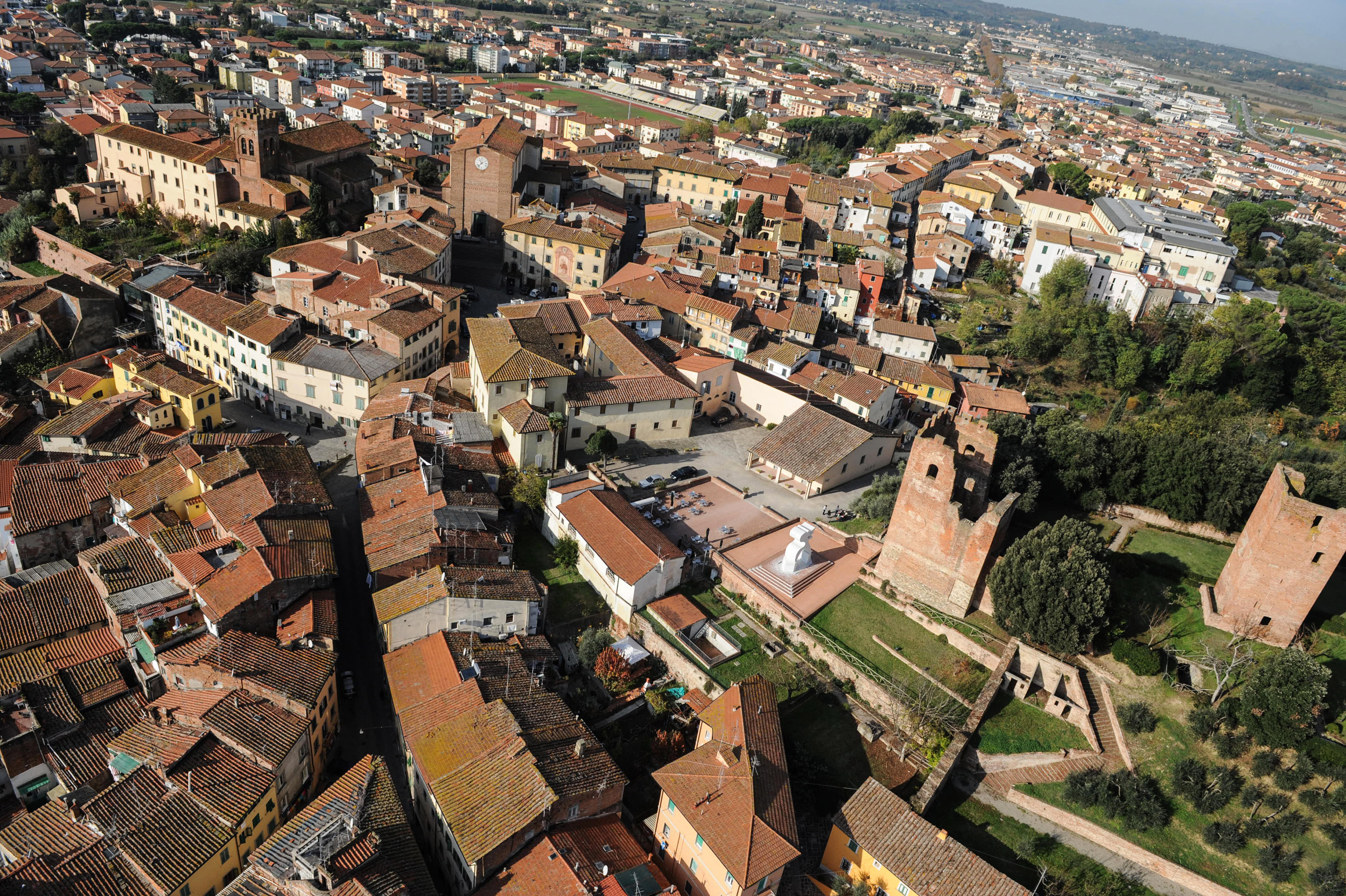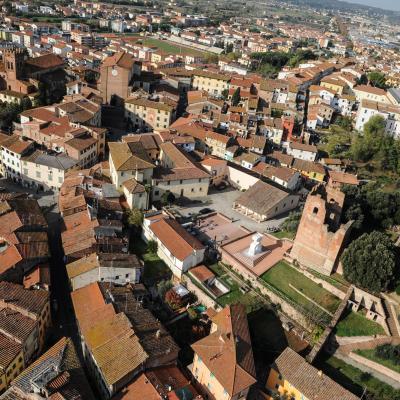The origin of the name Fucecchio has been the subject of several interpretations over time. The most likely origin is the one that derives its oldest form 'Ficeclum' (hence the later 'Ficecchium', then transformed into the current Fucecchio), from ficus or ficetulum, indicating the presence of numerous fig plants.
Other hypotheses, not to be completely excluded, refer to the form 'Focecchio', attested in recent times, as a derivation of a mouth - understood as a place of passage - or to 'Vicecclum', variation of the term vicus.

Le origini del nome Fucecchio
To explain the name Fucecchio, historians and scholars of the past have practiced with the most daring interpretations, which Egisto Lotti listed in his book published in 1936.
The oldest explanation, that made the most of popular imagination, was formulated already in XV century by Annio da Viterbo who, based on a document that later turned out to be a fake, made it derive from the Greek Phocians who escaped the destruction of Troy and came to Italy and elsewhere to create new settlements. So from the inhabitants of Phocis, which in Latin would have been called Focidis incolae or Focis incolae, for subsequent linguistic passages the name Fucecchio would have been born (Focis incolae, Focincolae Fociclae, Ficiclum, Ficeclum Focecchium, Fucecchium, Fucecchio, just to report some of the transformations hypothesized by Lotti). Unfortunately, this interpretation is based on a certainly false document and does not even stand up to a scientific linguistic analysis.
Another interpretation reported by Lotti suggests the derivation of the name from a circular foce a cerchio (mouth), which indicated a remote joining of the Arno with the rivers of the Valdinievole: a circle of waters formed by what is now called Usciana with a branch of the Arno then remained underground. Even this interpretation, although based on the plausible hypothesis of the intersection of two different courses of the Arno and the Usciana, known before the year 1000 also by the name Arme, does not hold up on a linguistic level.
Other hypotheses have referred to the Focecchio form with derivation from foce (mouth), a term used to indicate a place of passage. This interpretation could be acceptable, since Fucecchio has actually been a place of passage (around the year 1000 the first bridge over the Arno between Pisa and Florence was built there), and could also hold up on a linguistic level, but it clashes with the fact that the oldest name of Fucecchio was Ficeclum and not Focecchio, rarely documented only starting from the sixteenth century.
Finally, a variation from the term vicus in the form Vicecclum (a small vico, small inhabited center) should not be excluded, however, documented in a dubious way and only exceptionally.
Ficeclum is undoubtedly the most ancient and widespread word, which, after a very dubious testimony of 932, is affirmed with certainty since 1011 and then repeated, in the same form, in many papers relating to donations in favor of the abbey of San Salvatore during the eleventh century. Subsequently Ficeclum will evolve into the form Ficecchium (13th century), then Fucecchium (14th century), to finally arrive at the vulgar Italian Fucecchio (sometimes, as mentioned, also Focecchio, but rarely).
On the basis of these testimonies, linguistic experts interpret the name Ficeclum as a derivation from ficetulum, meaning “place of figs”, suggesting that the prevalent or more striking vegetation was formed around the year 1000 by figs. Obviously this is not a certainty, but a reasonable hypothesis based on linguistic traces.
In the earliest period this toponym designates, first of all, not an inhabited center but the whole area between the hill on which the historic center and the Arno stands today. In these years, between 1000 and 1100, the settlements, that is the two inhabited centers, instead bear the names of Borgonuovo, the village near the Arno, and Salamarzana, the castle built by the Cadolingi counts on the hill where the fortress is located today. At the end of the eleventh century the name indicates the curtis of Ficeclum, that is the territory that will subsequently expand until it coincides with the current administrative boundaries of the Municipality.
Source: Alberto Malvolti
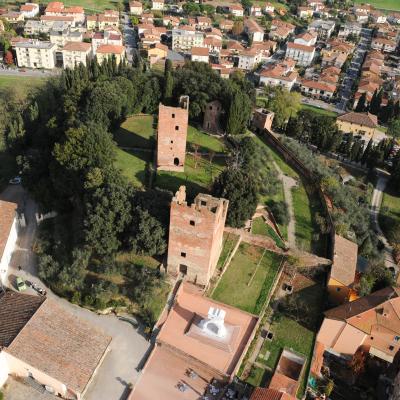
The Cadolingo origins
Fucecchio's origins are closely linked to the history of the Cadolingi Counts, a powerful house of Lombard origin that, around the year 1000, already owned lands and castles in the Valdinievole and the Lower Valdarno areas. Driven by the growing power of the Bishop of Pistoia to seek new spaces to assert their own autonomous power, they found in ‘place called fucecchio' the ideal conditions to build the center of a territorial lordship equidistant from the major cities (Pistoia, Lucca, Pisa and Florence) and at the intersection of important roads of land (the Via Francigena) and water (the Arno and the Gusciana, emissary of the Padule di Fucecchio). It was constructed, at a ford on the Arno, around the year 1000, the castle of Salamarzana, the first nucleus of the Fucecchiese settlement.
In 986, the Church of St. Salvatore, founded by Count Cadolo near the bridge over the Arno and the adjacent port, is documented for the first time. On the river, the second settlement was born a nucleus from which would develop the town of Fucecchio: Borgonuovo, a village that developed next to the Arno and grew by the continuous passage of merchants and pilgrims.
Shortly before the year 1000, Count Lotario, the son of Cadolo, joined the Church of St. Salvatore in a Benedictine monastery. The new institution, benefiting from numerous donations, became one of the most prestigious in the region managing to accumulate a vast wealth of land. In the early 12th century, a ruinous overflow of the Arno forced the monks to rebuild the buildings in a safer place on the hill near Salamarzana Castle (now a Poggio Salamartano). Since then, and to this day, even with modifications and renovations, the abbey and the adjacent church of St. John have constituted the main ecclesiastical center of the country.

The expansion of 1200
The dynasty of the Cadolingi became extinct in 1113, the castle went through a period of decadence, finding itself at the center of conflicts between the cities - Florence, Lucca and Pisa - that tried to occupy the abandoned space. It was during this period that a ruling class represented mainly by the families that had become powerful in the shadow of the Cadolingi accounts and which soon formed the consular class of the Municipality, formed at the end of the 12th century.
Over the course of the 1200s, years of intense growth followed. The monastery, at that time, in crisis, alienated the accumulated lands on which new dwellings had been built. After the middle of the century, when population growth was becoming more and more intense, the new villages fanned beyond the "old castle" descending in the direction of the Arno according to five axes that belonged to the oldest Castellana gate (the current Piazza Vittorio Veneto). Starting from the east they were: the contrada of Porta Raimonda (Via P. Martini), Borghetto (Via La Marmora), the village of Gattavaia, the contrada of dominus Bernardo (Via Donateschi) and the contrada of Sambuca, that is, the area between the current Piazza Cavour and Poggio Alberighi.
Such was the impulsive of growth that before the end of the twentieth century it was necessary to proceed to the construction of a new wall, which the new villages closed at noon. Thus, at the beginning of the 14th century, the urban footprint of Fucecchio Castle had been definitively consolidated.

The Plague and the Renaissance of 1500
In 1314 the municipality of Fucecchio broke away from the ancient dominant city, Lucca, and gradually approached Florence, to which it submitted to in 1330. In those years the castle had reached its maximum expansion approaching 3000 inhabitants, but the population growth was soon held back by a severe plague that, around the middle of the 14th century, raged throughout Europe: the population was decimated, the villages of the Cerbaie became unpopulated, the countryside was abandoned. In the early 15th century, the municipality of Fucecchio had only about one thousand inhabitants.
The recovery was slow and coincided with the gradual repopulation of the countryside starting in 1500. The low-cost sale of municipal land and the increasing presence of farms and land of wealthy Florentine owners, including the Medici, soon gave a new push to cultivate and harvest crops. This rebirth and expansion recalled many, giving rise, during the 17th century, to a new population growth: new churches were built and ecclesiastical buildings expanded, civil construction was renewed with the construction of the major local Nobile palaces.
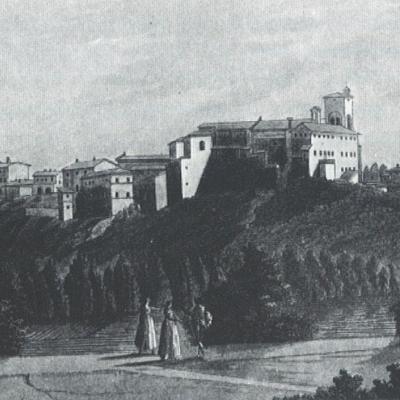
Fucecchio between the 1700s and 1800s
In the mid-1700s, population growth was even greater and faster, while important innovations were gaining in the surrounding countryside. Thanks to the sale to private individuals of the municipal heritage of Cerbaie and the farms that constituted the Grand Duchy farm of Cappiano Bridge, about a third of the municipal territory emerged from a centuries-old immobilism entering circulation and construction, or to the enlarging of family assets. The drainage of Fucecchio's "Lake", which was brought back after more than three centuries to the original condition of the marsh, also contributed to the recovery of unused land.
During the 1800s Fucecchio was again a populous town where the main activities are related to manufacturing, crafts and small trade but where there was still a real industrial burst and above all widespread poverty affected the population strategized more marginally. The first industrial-sized production nucleus was the Taddei match factory, which employed 600 men and women by the end of the century. It was only after the Second World War that Fucecchio met its true "industrial revolution" thanks to the development of the tannery industry and footwear sectors that multiplied employment by attracting substantial immigration from the south of the country.
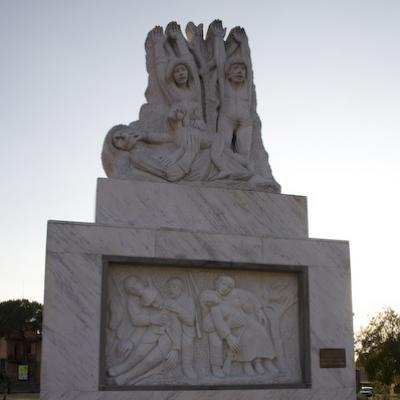
The Killing of the Padule
August 23, 1944 is an indelible date in everyone's memory. A terrible day for the Padule of Fucecchio, the scene of an act of war of a retreating army. The Germans surrounded the Padule at night and opened fire at dawn.
Babies, only a few months old, young mothers, the ill and elderly, unarmed men were judged as partisans - who were not there - and killed. There were 175 victims of Nazi-fascist terror. Few were saved, if only by a miracle. But there were those who, faced with the mangled bodies of family members, lose their sense of reason. Querce and Massarella, villages of the municipality of Fucecchio, mourned eight dead. The massacre also included Ponte Buggianese, Castelmartini (Larciano), Cintolese (Monsummano), Stabbia (Cerreto Guidi). Among the dead, locals, but also people who came from outside, displaced, arrived in search of safety; a long and excruciating list.
Late in the afternoon, the Germans - in the controls – celebrating their victory, singing, dancing and shouting the false ''Kaput Partisans''.
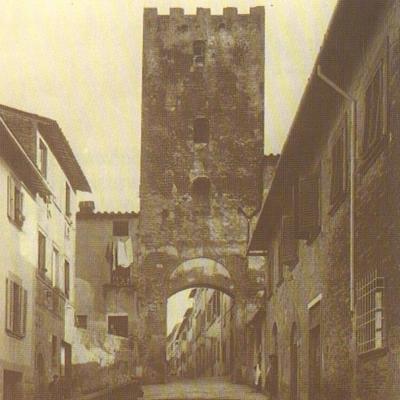
Liberation
Fucecchio was liberated on 1 September 1944 by the 6th South African Armoured Division and the 1st American Armored Division.
The announcement of the liberation was made by an American aircraft that landed, with two men on board, in the area of the Fucecchio Marsh north of Via di Burello.
On 2 September the township had a bleak outlook: houses destroyed or seriously damaged, piles of rubble on the streets, broken glass, wires of the electrical pipelines dangling, wreckage piled on the streets and squares.
And he came, light, in the field, the plane, in that beginning of September. Small. Loaded with hope. The end of anguish. Looking around here and there, then being looked at by the people, exiting the shelters dug into the side of the hill. Who had heard it and seen it and waved white towels. At first hesitant (but is he really American, our side?), then with exultation. Down from the Niccolai's retreat and beyond the canals of the Marsh, on Via Burello, without bridges. Everyone, the children in the front row, without fear of mines. Only one thought: it's over. Around the two soldiers smiling, shaking hands, giving kisses and hugs, and speaking broken Italian. But the people understood. They understood that the Germans were gone, that they were on the run. And they enjoyed the first moments of freedom (Riccardo Cardellicchio)
